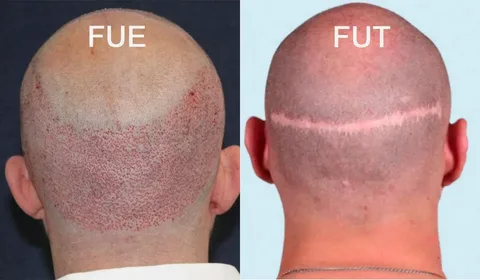If you’re considering a hair transplant, one major concern is the possibility of FUE scars. While FUE is known for its minimal invasiveness, scarring can still occur.
In this guide, we’ll explain how these scars form, how to prevent or treat them, and what to expect during recovery.
You’ll learn how expert care and good post-op habits can help you heal seamlessly and regain your confidence, with medically accurate, trustworthy insights throughout.
What Are FUE Scars?
Overview of the FUE Procedure
Follicular Unit Extraction (FUE) is a popular hair transplant technique that involves removing individual follicular units from the donor area, typically the back of the scalp.
These follicles are then implanted in areas experiencing hair thinning or loss.
FUE is favored for being less invasive than FUT (Follicular Unit Transplantation) and for not requiring a linear incision.
However, each tiny punch made during extraction leaves a small wound, which may heal with a subtle scar.
How Scarring Occurs in FUE
Despite being minimally invasive, FUE does result in microscars. These are usually dot-like and less visible, especially when:
- A skilled surgeon uses small punch tools (typically 0.7–0.9 mm)
- Proper aftercare is followed
- The patient’s healing response is normal
However, visible scarring may occur if:
- Larger punches are used
- The donor area is overharvested
- Post-op complications arise
Comparing FUE Scars to FUT Scars
| Technique | Scar Type | Visibility | Recovery |
|---|---|---|---|
| FUE | Multiple small circular scars | Low (especially with longer hair) | Faster |
| FUT | Single linear scar | It can be visible if the hair is short | Slightly longer |

Factors Influencing FUE Scarring
Surgical Technique and Equipment Used
The precision of the procedure depends heavily on the tools used and the surgeon’s expertise. Experienced surgeons minimize trauma, reduce punch size, and avoid overharvesting, resulting in more discreet scarring.
Pro Tip: Ask your clinic about punch sizes, number of grafts, and donor area planning during your consultation.
Individual Healing Responses
Everyone heals differently. Factors that influence scarring include:
- Age
- Skin type (e.g., keloid-prone skin)
- Genetics
- Existing medical conditions (like diabetes)
Post-Operative Care and Compliance
Strict adherence to post-op instructions is essential. Scratching, excessive sweating, or early exposure to sunlight can worsen scarring.
Preventing FUE Scars
Choosing an Experienced Surgeon
The most critical decision is your surgeon. Look for:
- Proven track record in FUE
- Positive patient reviews
- Before-and-after galleries
- Certifications from recognized boards
Expert Insight: “Technique and planning are as important as tools. A conservative approach always leads to better aesthetics long term,” says Dr. Rana Irfan, FUE specialist in Islamabad.
Adhering to Post-Operative Instructions
Follow all medical guidance, including:
- Avoiding strenuous exercise for at least 10–14 days
- Sleeping with your head elevated
- Using prescribed shampoos and topical treatments
- Not scratching or picking at the donor area

Lifestyle Modifications to Promote Healing
- Stay hydrated
- Avoid alcohol and smoking
- Eat a protein-rich diet
- Limit sun exposure on the scalp
Treatment Options for Existing FUE Scars
Medical Treatments
- Laser therapy: Fractional CO2 lasers can improve skin texture and reduce scar pigmentation.
- Microneedling: Enhances collagen production, making scars less visible.
- Platelet-Rich Plasma (PRP): Promotes healing and regeneration in scarred tissue.
Cosmetic Solutions
- Scalp Micropigmentation (SMP): Tattoos the appearance of hair follicles over scarred areas.
- Camouflage with hair growth: If donor hair density allows, further FUE sessions may help cover scars.
Natural Remedies and Their Efficacy
While some advocate for oils like rosehip or vitamin E, these are best used as a supplementary option, not replacements for medical treatments. Always consult a specialist before starting topical remedies.
Expert Insights on FUE Scarring
Quotes from Leading Hair Restoration Specialists
“FUE scars are real, but they’re often minor and manageable with proper care. Prevention starts with your surgeon selection,” – Dr. Rana Irfan
Case Studies Highlighting Successful Scar Management
- Case 1: Male, 32 — noticeable scarring reduced by 80% after 4 sessions of fractional laser and SMP.
- Case 2: Female, 45 — used PRP and dermaroller therapy to soften scar tissue after overharvesting in a previous procedure.

Frequently Asked Questions (FAQs)
Are FUE Scars Permanent?
Yes, FUE scars are technically permanent, but they often become barely visible with proper healing and hair regrowth.
Can FUE Scars Be Completely Removed?
They can’t be fully removed, but can be significantly reduced or concealed with treatments like SMP or laser therapy.
How Long Does It Take for FUE Scars to Heal?
Initial healing takes 1–2 weeks, but scar remodeling continues for up to 12 months.
Is It Safe to Undergo a Second FUE Procedure?
Yes, if the donor area is healthy. A consultation is needed to assess scar tissue and hair density.
Conclusion
FUE scars are an important consideration in your hair transplant journey, but with the right surgeon and care, they are manageable and often barely noticeable.
Understanding how they form, how to treat them, and how to prevent them gives you the power to take control of your recovery.
Ready for a scar-free, confident look?
Book a consultation with Dr. Rana Irfan in Islamabad today—a leading expert in FUE transplants and scar management. Get personalized advice, transparent expectations, and a smoother path to recovery.
